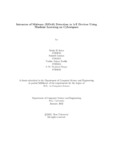| dc.contributor.advisor | Arif, Hossain | |
| dc.contributor.author | Al Amin, Istiak | |
| dc.contributor.author | Lamiya, Salsabil | |
| dc.contributor.author | Sheikh, Noshin Anjum | |
| dc.contributor.author | Haque, S. M. Tanjimul | |
| dc.date.accessioned | 2022-07-17T08:36:41Z | |
| dc.date.available | 2022-07-17T08:36:41Z | |
| dc.date.copyright | 2022 | |
| dc.date.issued | 2022-01 | |
| dc.identifier.other | ID: 17201025 | |
| dc.identifier.other | ID: 17201115 | |
| dc.identifier.other | ID: 17201114 | |
| dc.identifier.other | ID: 17301095 | |
| dc.identifier.uri | http://hdl.handle.net/10361/17018 | |
| dc.description | This thesis is submitted in partial fulfillment of the requirements for the degree of Bachelor of Science in Computer Science, 2022. | en_US |
| dc.description | Cataloged from PDF version of thesis. | |
| dc.description | Includes bibliographical references (pages 36-37). | |
| dc.description.abstract | Nowadays, the number of interconnected devices (IoT) is increasing dramatically.
This expansion poses new security problems for network operators, IoT service
providers, and users. Security measures implemented on IoT devices are getting
complex due to their heterogeneity and constraints. Attackers have utilized IoT
devices to execute massive attacks like DDoS, Zero-Day-Exploitation, Ransomware,
etc. The most significant measure to safeguard services from insecure IoT devices
is to increase security consciousness in the core network. On the other hand, this
thesis suggests a machine learning DDoS detection and diminution technique. The
proposed approach was assessed by applying five supervised machine learning classification methods. The evaluation findings reveal that k-NN and Random Forest
algorithms outperform ANN, SVM, and Naïve Bayes algorithms. Consequently, the
findings of this study can assist academics in further research on malware detection
systems for IoT devices. | en_US |
| dc.description.statementofresponsibility | Istiak Al Amin | |
| dc.description.statementofresponsibility | Salsabil Lamiya | |
| dc.description.statementofresponsibility | Noshin Anjum Sheikh | |
| dc.description.statementofresponsibility | S. M. Tanjimul Haque | |
| dc.format.extent | 37 Pages | |
| dc.language.iso | en_US | en_US |
| dc.publisher | Brac University | en_US |
| dc.rights | Brac University theses are protected by copyright. They may be viewed from this source for any purpose, but reproduction or distribution in any format is prohibited without written permission. | |
| dc.subject | IoT | en_US |
| dc.subject | DDoS | en_US |
| dc.subject | k-Nearest-Neighbour | en_US |
| dc.subject | Random Forest | en_US |
| dc.subject | Naive Bayes | en_US |
| dc.subject | Artificial Neural Network | en_US |
| dc.subject | Support Vector Machine | en_US |
| dc.subject | Cyberspace | en_US |
| dc.subject.lcsh | Internet of things | |
| dc.subject.lcsh | Machine learning | |
| dc.title | Intrusion of Malware (DDoS) detection in IoT devices using Machine Learning on Cyberspace | en_US |
| dc.type | Thesis | en_US |
| dc.contributor.department | Department of Computer Science and Engineering, Brac University | |
| dc.description.degree | B. Computer Science | |

